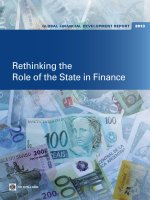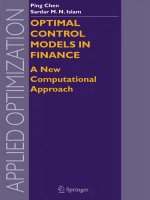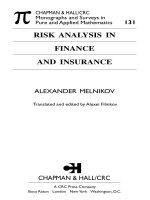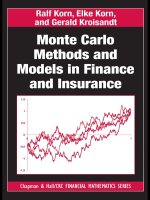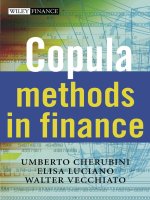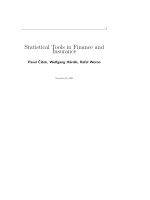Bayesian methods in finance
Bạn đang xem bản rút gọn của tài liệu. Xem và tải ngay bản đầy đủ của tài liệu tại đây (2.71 MB, 352 trang )
Bayesian
Methods
in Finance
SVETLOZAR T. RACHEV
JOHN S. J. HSU
BILIANA S. BAGASHEVA
FRANK J. FABOZZI
John Wiley & Sons, Inc.
Bayesian
Methods
in Finance
THE FRANK J. FABOZZI SERIES
Fixed Income Securities, Second Edition by Frank J. Fabozzi
Focus on Value: A Corporate and Investor Guide to Wealth Creation by James L. Grand and James
A. Abater
Handbook of Global Fixed Income Calculations by Dragomir Krgin
Managing a Corporate Bond Portfolio by Leland E. Crabbe and Frank J. Fabozzi
Real Options and Option-Embedded Securities by William T. Moore
Capital Budgeting: Theory and Practice by Pamela P. Peterson and Frank J. Fabozzi
The Exchange-Traded Funds Manual by Gary L. Gastineau
Professional Perspectives on Fixed Income Portfolio Management, Volume 3 edited by Frank J. Fabozzi
Investing in Emerging Fixed Income Markets edited by Frank J. Fabozzi and Efstathia Pilarinu
Handbook of Alternative Assests by Mark J. P. Anson
The Exchange-Trade Funds Manual by Gary L. Gastineau
The Global Money Markets by Frank J. Fabozzi, Steven V. Mann, and Moorad Choudhry
The Handbook of Financial Instruments edited by Frank J. Fabozzi
Collateralized Debt Obligations: Structures and Analysis by Laurie S. Goodman and Frank J. Fabozzi
Interest Rate, Term Structure, and Valuation Modeling edited by Frank J. Fabozzi
Investment Performance Measurement by Bruce J. Feibel
The Handbook of Equity Style Management edited by T. Daniel Coggin and Frank J. Fabozzi
The Theory and Practice of Investment Management edited by Frank J. Fabozzi and Harry M. Markowitz
Foundations of Economics Value Added: Second Edition by James L. Grant
Financial Management and Analysis: Second Edition by Frank J. Fabozzi and Pamela P. Peterson
Measuring and Controlling Interest Rate and Credit Risk: Second Edition by Frank J. Fabozzi, Steven
V. Mann, and Moorad Choudhry
Professional Perspectives on Fixed Income Portfolio Management, Volume 4 edited by Frank J. Fabozzi
The Handbook of European Fixed Income Securities edited by Frank J. Fabozzi and Moorad Choudhry
The Handbook of European Structured Financial Products edited by Frank J. Fabozzi and Moorad
Choudhry
The Mathematics of Financial Modeling and Investment Management by Sergio M. Focardi and Frank
J. Fabozzi
Short Selling: Strategies, Risk and Rewards edited by Frank J. Fabozzi
The Real Estate Investment Handbook by G. Timothy Haight and Daniel Singer
Market Neutral: Strategies edited by Bruce I. Jacobs and Kenneth N. Levy
Securities Finance: Securities Lending and Repurchase Agreements edited by Frank J. Fabozzi and Steven
V. Mann
Fat-Tailed and Skewed Asset Return Distributions by Svetlozar T. Rachev, Christian Menn, and Frank
J. Fabozzi
Financial Modeling of the Equity Market: From CAPM to Cointegration by Frank J. Fabozzi, Sergio
M. Focardi, and Petter N. Kolm
Advanced Bond Portfolio management: Best Practices in Modeling and Strategies edited by Frank
J. Fabozzi, Lionel Martellini, and Philippe Priaulet
Analysis of Financial Statements, Second Edition by Pamela P. Peterson and Frank J. Fabozzi
Collateralized Debt Obligations: Structures and Analysis, Second Edition by Douglas J. Lucas, Laurie
S. Goodman, and Frank J. Fabozzi
Handbook of Alternative Assets, Second Edition by Mark J. P. Anson
Introduction to Structured Finance by Frank J. Fabozzi, Henry A. Davis, and Moorad Choudhry
Financial Econometrics by Svetlozar T. Rachev, Stefan Mittnik, Frank J. Fabozzi, Sergio M. Focardi, and
Teo Jasic
Developments in Collateralized Debt Obligations: New Products and Insights by Douglas J. Lucas, Laurie
S. Goodman, Frank J. Fabozzi, and Rebecca J. Manning
Robust Portfolio Optimization and Management by Frank J. Fabozzi, Peter N. Kolm, Dessislava
A. Pachamanova, and Sergio M. Focardi
Advanced Stochastic Models, Risk Assesment, and Portfolio Optimizations by Svetlozar T. Rachev, Stogan
V. Stoyanov, and Frank J. Fabozzi
How to Select Investment Managers and Evalute Performance by G. Timothy Haight, Stephen O. Morrell,
and Glenn E. Ross
Bayesian Methods in Finance by Svetlozar T. Rachev, John S. J. Hsu, Biliana S. Bagasheva, and Frank
J. Fabozzi
Bayesian
Methods
in Finance
SVETLOZAR T. RACHEV
JOHN S. J. HSU
BILIANA S. BAGASHEVA
FRANK J. FABOZZI
John Wiley & Sons, Inc.
Copyright c 2008 by John Wiley & Sons, Inc. All rights reserved.
Published by John Wiley & Sons, Inc., Hoboken, New Jersey.
Published simultaneously in Canada.
No part of this publication may be reproduced, stored in a retrieval system, or transmitted in
any form or by any means, electronic, mechanical, photocopying, recording, scanning, or
otherwise, except as permitted under Section 107 or 108 of the 1976 United States Copyright
Act, without either the prior written permission of the Publisher, or authorization through
payment of the appropriate per-copy fee to the Copyright Clearance Center, Inc., 222
Rosewood Drive, Danvers, MA 01923, (978) 750-8400, fax (978) 750-4470, or on the Web
at www.copyright.com. Requests to the Publisher for permission should be addressed to the
Permissions Department, John Wiley & Sons, Inc., 111 River Street, Hoboken, NJ 07030,
(201) 748-6011, fax (201) 748-6008, or online at />Limit of Liability/Disclaimer of Warranty: While the publisher and author have used their
best efforts in preparing this book, they make no representations or warranties with respect to
the accuracy or completeness of the contents of this book and specifically disclaim any implied
warranties of merchantability or fitness for a particular purpose. No warranty may be created
or extended by sales representatives or written sales materials. The advice and strategies
contained herein may not be suitable for your situation. You should consult with a
professional where appropriate. Neither the publisher nor author shall be liable for any loss of
profit or any other commercial damages, including but not limited to special, incidental,
consequential, or other damages.
For general information on our other products and services or for technical support, please
contact our Customer Care Department within the United States at (800) 762-2974, outside
the United States at (317) 572-3993, or fax (317) 572-4002.
Wiley also publishes its books in a variety of electronic formats. Some content that appears in
print may not be available in electronic books. For more information about Wiley products,
visit our Web site at www.wiley.com.
ISBN: 978-0-471-92083-0
Printed in the United States of America.
10
9 8
7
6 5
4
3
2 1
S.T.R.
To Iliana and Zoya
J.S.J.H.
To Serene, Justin, and Andrew
B.S.B.
To my mother, Gokhan,
and my other loved ones
¨
F.J.F.
To my wife Donna and my children Francesco,
Patricia, and Karly
Contents
Preface
About the Authors
CHAPTER 1
Introduction
A Few Notes on Notation
Overview
CHAPTER 2
The Bayesian Paradigm
The Likelihood Function
The Poisson Distribution Likelihood Function
The Normal Distribution Likelihood Function
The Bayes’ Theorem
Bayes’ Theorem and Model Selection
Bayes’ Theorem and Classification
Bayesian Inference for the Binomial Probability
Summary
xv
xvii
1
3
4
6
6
7
9
10
14
14
15
21
CHAPTER 3
Prior and Posterior Information, Predictive Inference
22
Prior Information
Informative Prior Elicitation
Noninformative Prior Distributions
Conjugate Prior Distributions
Empirical Bayesian Analysis
Posterior Inference
Posterior Point Estimates
Bayesian Intervals
Bayesian Hypothesis Comparison
Bayesian Predictive Inference
22
23
25
27
28
30
30
32
32
34
vii
viii
CONTENTS
Illustration: Posterior Trade-off and the Normal Mean
Parameter
Summary
Appendix: Definitions of Some Univariate and Multivariate
Statistical Distributions
The Univariate Normal Distribution
The Univariate Student’s t-Distribution
The Inverted χ 2 Distribution
The Multivariate Normal Distribution
The Multivariate Student’s t-Distribution
The Wishart Distribution
The Inverted Wishart Distribution
CHAPTER 4
Bayesian Linear Regression Model
The Univariate Linear Regression Model
Bayesian Estimation of the Univariate Regression
Model
Illustration: The Univariate Linear Regression Model
The Multivariate Linear Regression Model
Diffuse Improper Prior
Summary
CHAPTER 5
Bayesian Numerical Computation
Monte Carlo Integration
Algorithms for Posterior Simulation
Rejection Sampling
Importance Sampling
MCMC Methods
Linear Regression with Semiconjugate Prior
Approximation Methods: Logistic Regression
The Normal Approximation
The Laplace Approximation
Summary
CHAPTER 6
Bayesian Framework For Portfolio Allocation
Classical Portfolio Selection
Portfolio Selection Problem Formulations
35
37
38
39
39
39
40
40
41
41
43
43
45
53
56
58
60
61
61
63
64
65
66
77
82
84
89
90
92
94
95
Contents
Mean-Variance Efficient Frontier
Illustration: Mean-Variance Optimal Portfolio
with Portfolio Constraints
Bayesian Portfolio Selection
Prior Scenario 1: Mean and Covariance with Diffuse
(Improper) Priors
Prior Scenario 2: Mean and Covariance with Proper
Priors
The Efficient Frontier and the Optimal Portfolio
Illustration: Bayesian Portfolio Selection
Shrinkage Estimators
Unequal Histories of Returns
Dependence of the Short Series on the Long Series
Bayesian Setup
Predictive Moments
Summary
CHAPTER 7
Prior Beliefs and Asset Pricing Models
Prior Beliefs and Asset Pricing Models
Preliminaries
Quantifying the Belief About Pricing Model Validity
Perturbed Model
Likelihood Function
Prior Distributions
Posterior Distributions
Predictive Distributions and Portfolio Selection
Prior Parameter Elicitation
Illustration: Incorporating Confidence about the
Validity of an Asset Pricing Model
Model Uncertainty
Bayesian Model Averaging
Illustration: Combining Inference from the CAPM and
the Fama and French Three-Factor Model
Summary
Appendix A: Numerical Simulation of the Predictive
Distribution
Sampling from the Predictive Distribution
Appendix B: Likelihood Function of a Candidate Model
ix
97
99
101
102
103
105
106
108
110
112
112
113
116
118
119
119
121
121
122
123
124
126
127
128
129
131
134
135
135
136
138
x
CONTENTS
CHAPTER 8
The Black-Litterman Portfolio Selection Framework
Preliminaries
Equilibrium Returns
Investor Views
Distributional Assumptions
Combining Market Equilibrium and Investor Views
The Choice of τ and
The Optimal Portfolio Allocation
Illustration: Black-Litterman Optimal Allocation
Incorporating Trading Strategies into the Black-Litterman
Model
Active Portfolio Management and the Black-Litterman
Model
Views on Alpha and the Black-Litterman Model
Translating a Qualitative View into a Forecast for
Alpha
Covariance Matrix Estimation
Summary
CHAPTER 9
Market Efficiency and Return Predictability
Tests of Mean-Variance Efficiency
Inefficiency Measures in Testing the CAPM
Distributional Assumptions and Posterior
Distributions
Efficiency under Investment Constraints
Illustration: The Inefficiency Measure, R
Testing the APT
Distributional Assumptions, Posterior and Predictive
Distributions
Certainty Equivalent Returns
Return Predictability
Posterior and Predictive Inference
Solving the Portfolio Selection Problem
Illustration: Predictability and the Investment Horizon
Summary
Appendix: Vector Autoregressive Setup
141
142
142
144
144
146
147
148
149
153
154
157
158
159
161
162
164
167
168
169
170
171
172
173
175
177
180
182
183
183
Contents
CHAPTER 10
Volatility Models
Garch Models of Volatility
Stylized Facts about Returns
Modeling the Conditional Mean
Properties and Estimation of the GARCH(1,1) Process
Stochastic Volatility Models
Stylized Facts about Returns
Estimation of the Simple SV Model
Illustration: Forecasting Value-at-Risk
An Arch-Type Model or a Stochastic Volatility Model?
Where Do Bayesian Methods Fit?
CHAPTER 11
Bayesian Estimation of ARCH-Type Volatility Models
Bayesian Estimation of the Simple GARCH(1,1) Model
Distributional Setup
Mixture of Normals Representation of the Student’s
t-Distribution
GARCH(1,1) Estimation Using the
Metropolis-Hastings Algorithm
Illustration: Student’s t GARCH(1,1) Model
Markov Regime-switching GARCH Models
Preliminaries
Prior Distributional Assumptions
Estimation of the MS GARCH(1,1) Model
Sampling Algorithm for the Parameters of the MS
GARCH(1,1) Model
Illustration: Student’s t MS GARCH(1,1) Model
Summary
Appendix: Griddy Gibbs Sampler
Drawing from the Conditional Posterior Distribution
of ν
CHAPTER 12
Bayesian Estimation of Stochastic Volatility Models
Preliminaries of SV Model Estimation
Likelihood Function
The Single-Move MCMC Algorithm for SV Model
Estimation
xi
185
187
188
189
190
194
195
195
198
200
200
202
203
204
206
208
211
214
215
217
218
222
222
225
226
227
229
230
231
232
xii
CONTENTS
Prior and Posterior Distributions
Conditional Distribution of the Unobserved Volatility
Simulation of the Unobserved Volatility
Illustration
The Multimove MCMC Algorithm for SV Model Estimation
Prior and Posterior Distributions
Block Simulation of the Unobserved Volatility
Sampling Scheme
Illustration
Jump Extension of the Simple SV Model
Volatility Forecasting and Return Prediction
Summary
Appendix: Kalman Filtering and Smoothing
The Kalman Filter Algorithm
The Smoothing Algorithm
CHAPTER 13
Advanced Techniques for Bayesian Portfolio Selection
Distributional Return Assumptions Alternative to Normality
Mixtures of Normal Distributions
Asymmetric Student’s t-Distributions
Stable Distributions
Extreme Value Distributions
Skew-Normal Distributions
The Joint Modeling of Returns
Portfolio Selection in the Setting of Nonnormality:
Preliminaries
Maximization of Utility with Higher Moments
Coskewness
Utility with Higher Moments
Distributional Assumptions and Moments
Likelihood, Prior Assumptions, and Posterior
Distributions
Predictive Moments and Portfolio Selection
Illustration: HLLM’s Approach
Extending The Black-Litterman Approach: Copula Opinion
Pooling
Market-Implied and Subjective Information
Views and View Distributions
Combining the Market and the Views:The Marginal
Posterior View Distributions
232
233
234
236
237
237
239
241
241
241
243
244
244
244
246
247
248
249
250
251
252
253
254
255
256
257
258
259
259
262
263
263
264
265
266
Contents
Views Dependence Structure:The Joint Posterior View
Distribution
Posterior Distribution of the Market Realizations
Portfolio Construction
Illustration: Meucci’s Approach
Extending The Black-Litterman Approach:Stable
Distribution
Equilibrium Returns Under Nonnormality
Summary
APPENDIX A: Some Risk Measures Employed in Portfolio
Construction
APPENDIX B: CVaR Optimization
APPENDIX C: A Brief Overview of Copulas
CHAPTER 14
Multifactor Equity Risk Models
Preliminaries
Statistical Factor Models
Macroeconomic Factor Models
Fundamental Factor Models
Risk Analysis Using a Multifactor Equity Model
Covariance Matrix Estimation
Risk Decomposition
Return Scenario Generation
Predicting the Factor and Stock-Specific Returns
Risk Analysis in a Scenario-Based Setting
Conditional Value-at-Risk Decomposition
Bayesian Methods for Multifactor Models
Cross-Sectional Regression Estimation
Posterior Simulations
Return Scenario Generation
Illustration
Summary
xiii
267
267
268
269
270
270
272
273
276
277
280
281
281
282
282
283
283
285
287
288
288
289
292
293
293
294
294
295
References
298
Index
311
Preface
his book provides the fundamentals of Bayesian methods and their
applications to students in finance and practitioners in the financial
services sector. Our objective is to explain the concepts and techniques that
can be applied in real-world Bayesian applications to financial problems.
While statistical modeling has been used in finance for the last four or
five decades, recent years have seen an impressive growth in the variety of
models and modeling techniques used in finance, particularly in portfolio
management and risk management. As part of this trend, Bayesian methods
are enjoying a rediscovery by academics and practitioners alike and growing
in popularity. The choice of topics in this book reflects the current major
developments of Bayesian applications to risk management and portfolio
management.
Three fundamental factors are behind the increased adoption of Bayesian
methods by the financial community. Bayesian methods provide (1) a theoretically sound framework for combining various sources of information;
(2) a robust estimation setting that incorporates explicitly estimation risk;
and (3) the flexibility to handle complex and realistic models. We believe
this book is the first of its kind to present and discuss Bayesian financial
applications. The fundamentals of Bayesian analysis and Markov Chain
Monte Carlo are covered in Chapters 2 through 5 and the applications are
introduced in the remaining chapters. Each application presentation begins
with the basics, works through the frequentist perspective, followed by the
Bayesian treatment.
The applications include:
T
■
■
■
■
The Bayesian approach to mean-variance portfolio selection and its
advantages over the frequentist approach (Chapters 6 and 7).
A general framework for reflecting degrees of belief in an asset pricing
model when selecting the optimal portfolio (Chapters 6 and 7).
Bayesian methods to portfolio selection within the context of the
Black-Litterman model and extensions to it (Chapter 8).
Computing measures of market efficiency and the way predictability
influences optimal portfolio selection (Chapter 9).
xv
xvi
PREFACE
■
Volatility modeling (ARCH-type and SV models) focusing on the various numerical methods available for Bayesian estimation (Chapters 10,
11, and 12).
Advanced techniques for model selection, notably in the setting of
nonnormality of stock returns (Chapter 13).
Multifactor models of stock returns, including risk attribution in both
an analytical and a numerical setting (Chapter 14).
■
■
ACKNOWLEDGMENTS
We thank several individuals for their assistance in various aspects of this
project. Thomas Leonard provided us with guidance on several theoretical
issues that we encountered. Doug Steigerwald of the University of California–Santa Barbara directed us in the preparation of the discussion on the
efficient methods of moments in Chapter 10.
Svetlozar Rachev gratefully acknowledges research support by grants
from Division of Mathematical, Life and Physical Sciences, College of
Letters and Science, University of California–Santa Barbara; the Deutschen
Forschungsgemeinschaft; and the Deutscher Akademischer Austausch Dienst.
Biliana Bagasheva gratefully acknowledges the support of the Fulbright
Program at the Institute of International Education and the Department
of Statistics and Applied Probability, University of California–Santa Barbara. Lastly, Frank Fabozzi gratefully acknowledges the support of Yale’s
International Center for Finance.
Svetlozar T. Rachev
John S. J. Hsu
Biliana S. Bagasheva
Frank J. Fabozzi
About the Authors
vetlozar (Zari) T. Rachev completed his Ph.D. degree in 1979 from
Moscow State (Lomonosov) University and his doctor of science degree
in 1986 from Steklov Mathematical Institute in Moscow. Currently, he is
chair-professor in statistics, econometrics and mathematical finance at the
University of Karlsruhe in the School of Economics and Business Engineering. He is also Professor Emeritus at the University of California–Santa
Barbara in the Department of Statistics and Applied Probability. He has
published seven monographs, eight handbooks, and special-edited volumes,
and over 250 research articles. His recently coauthored books published
by John Wiley & Sons in mathematical finance and financial econometrics include Financial Econometrics: From Basics to Advanced Modeling
Techniques (2007); Operational Risk: A Guide to Basel II Capital Requirements, Models, and Analysis (2007); and Advanced Stochastic Models, Risk
Assessment and Portfolio Optimization: The Ideal Risk, Uncertainty, and
Performance Measures (2008). Professor Rachev is cofounder of Bravo Risk
Management Group specializing in financial risk-management software.
Bravo Group was recently acquired by FinAnalytica, for which he currently
serves as chief-scientist.
John S. J. Hsu is professor of statistics and applied probability at
the University of California, Santa Barbara. He is also a faculty member
in the University’s Center for Research in Financial Mathematics and
Statistics. He obtained his Ph.D. in statistics with a minor in business
from the University of Wisconsin–Madison in 1990. Professor Hsu has
published numerous papers and coauthored a Cambridge University Press
advanced series text, Bayesian Methods: An Analysis for Statisticians and
Interdisciplinary Researchers (1999), with Thomas Leonard.
Biliana S. Bagasheva completed her Ph.D. in Statistics at the University
of California–Santa Barbara. Her research interests include risk management, portfolio construction, Bayesian methods, and financial econometrics.
Currently, Biliana is a consultant in London.
Frank J. Fabozzi is Professor in the Practice of Finance in the School
of Management at Yale University. Prior to joining the Yale faculty, he
was a visiting professor of finance in the Sloan School at MIT. He is
a Fellow of the International Center for Finance at Yale University and
on the Advisory Council for the Department of Operations Research and
S
xvii
xviii
ABOUT THE AUTHORS
Financial Engineering at Princeton University. Professor Fabozzi is the
editor of the Journal of Portfolio Management. His recently coauthored
books published by John Wiley & Sons in mathematical finance and
financial econometrics include The Mathematics of Financial Modeling and
Investment Management (2004); Financial Modeling of the Equity Market:
From CAPM to Cointegration (2006); Robust Portfolio Optimization and
Management (2007); and Advanced Stochastic Models, Risk Assessment,
and Portfolio Optimization: The Ideal Risk, Uncertainty and Performance
Measures (2008). He earned a doctorate in economics from the City
University of New York in 1972. In 2002, he was inducted into the
Fixed Income Analysts Society’s Hall of Fame and is the 2007 recipient of
the C. Stewart Sheppard Award given by the CFA Institute. He earned the
designation of Chartered Financial Analyst and Certified Public Accountant.
He has authored and edited numerous books in finance.
Bayesian
Methods
in Finance
CHAPTER
1
Introduction
uantitative financial models describe in mathematical terms the relationships between financial random variables through time and/or across
assets. The fundamental assumption is that the model relationship is valid
independent of the time period or the asset class under consideration.
Financial data contain both meaningful information and random noise. An
adequate financial model not only extracts optimally the relevant information from the historical data but also performs well when tested with new
data. The uncertainty brought about by the presence of data noise makes
imperative the use of statistical analysis as part of the process of financial
model building, model evaluation, and model testing.
Statistical analysis is employed from the vantage point of either
of the two main statistical philosophical traditions—‘‘frequentist’’ and
‘‘Bayesian.’’ An important difference between the two lies with the interpretation of the concept of probability. As the name suggests, advocates of
frequentist statistics adopt a frequentist interpretation: The probability of
an event is the limit of its long-run relative frequency (i.e., the frequency
with which it occurs as the amount of data increases without bound). Strict
adherence to this interpretation is not always possible in practice. When
studying rare events, for instance, large samples of data may not be available
and in such cases proponents of frequentist statistics resort to theoretical
results. The Bayesian view of the world is based on the subjectivist interpretation of probability: Probability is subjective, a degree of belief that is
updated as information or data are acquired.1
Q
1
The concept of subjective probability is derived from arguments for rationality of
the preferences of agents. It originated in the 1930s with the (independent) works of
Bruno de Finetti and Frank Ramsey, and was further developed by Leonard Savage
and Dennis Lindley. The subjective probability interpretation can be traced back to
the Scottish philosopher and economist David Hume, who also had philosophical
influence over Harry Markowitz (by Markowitz’s own words in his autobiography
1
2
BAYESIAN METHODS IN FINANCE
Closely related to the concept of probability is that of uncertainty.
Proponents of the frequentist approach consider the source of uncertainty
to be the randomness inherent in realizations of a random variable. The
probability distributions of variables are not subject to uncertainty. In
contrast, Bayesian statistics treats probability distributions as uncertain and
subject to modification as new information becomes available. Uncertainty
is implicitly incorporated by probability updating. The probability beliefs
based on the existing knowledge base take the form of the prior probability.
The posterior probability represents the updated beliefs.
Since the beginning of last century, when quantitative methods and
models became a mainstream tool to aid in understanding financial markets
and formulating investment strategies, the framework applied in finance
has been the frequentist approach. The term ‘‘frequentist’’ usually refers
to the Fisherian philosophical approach named after Sir Ronald Fisher.
Strictly speaking, ‘‘Fisherian’’ has a broader meaning as it includes not
only frequentist statistical concepts such as unbiased estimators, hypothesis
tests, and confidence intervals, but also the maximum likelihood estimation
framework pioneered by Fisher. Only in the last two decades has Bayesian
statistics started to gain greater acceptance in financial modeling, despite its
introduction about 250 years ago by Thomas Bayes, a British minister and
mathematician. It has been the advancements of computing power and the
development of new computational methods that has fostered the growing
use of Bayesian statistics in finance.
On the applicability of the Bayesian conceptual framework, consider an
excerpt from the speech of former chairman of the Board of Governors of
the Federal Reserve System, Alan Greenspan:
The Federal Reserve’s experiences over the past two decades make
it clear that uncertainty is not just a pervasive feature of the
monetary policy landscape; it is the defining characteristic of that
landscape. The term ‘‘uncertainty’’ is meant here to encompass
both ‘‘Knightian uncertainty,’’ in which the probability distribution
of outcomes is unknown, and ‘‘risk,’’ in which uncertainty of
outcomes is delimited by a known probability distribution. [. . . ]
This conceptual framework emphasizes understanding as much as
possible the many sources of risk and uncertainty that policymakers
face, quantifying those risks when possible, and assessing the costs
associated with each of the risks. In essence, the risk management
published in Les Prix Nobel (1991)). Holton (2004) provides a historical background
of the development of the concepts of risk and uncertainty.
